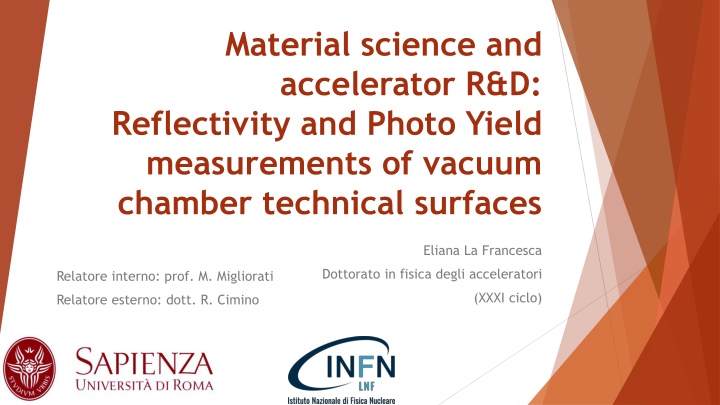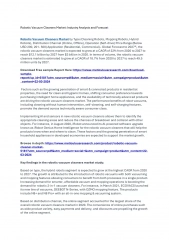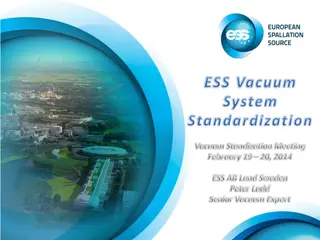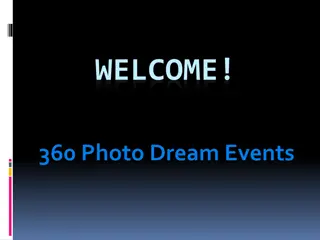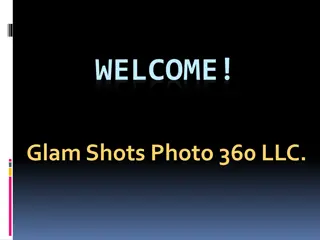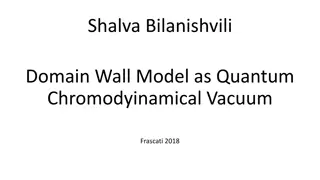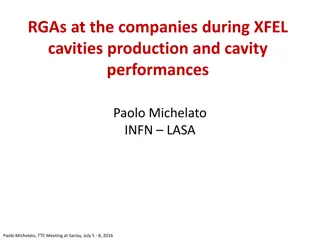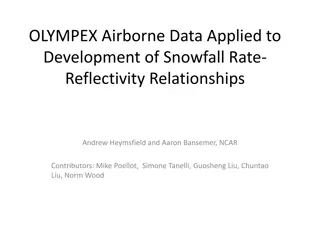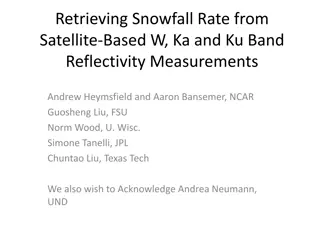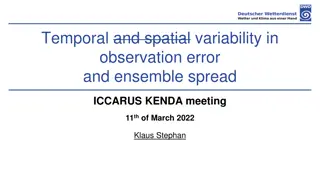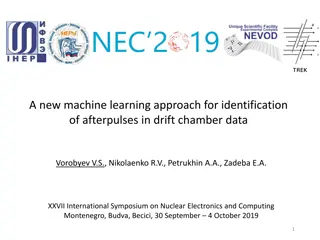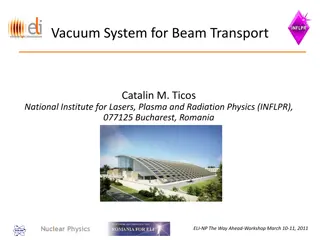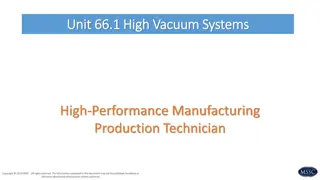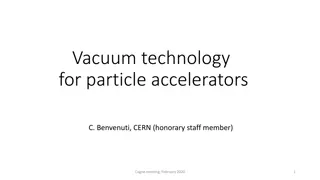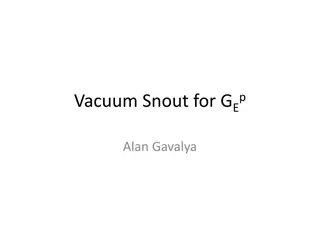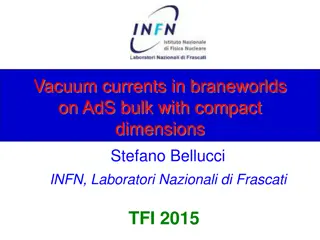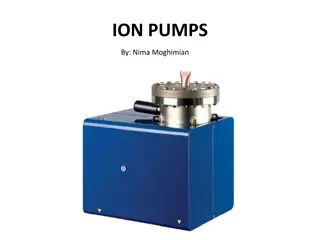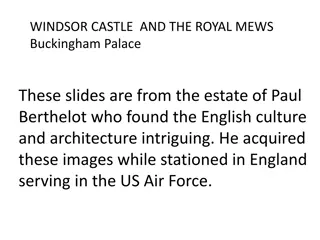Reflectivity and Photo-Yield Measurements for Vacuum Chamber Surfaces
Eliana La Francesca's doctoral research in accelerator physics focused on studying the impact of synchrotron radiation on vacuum chamber surfaces. By analyzing reflectivity and photo-yield measurements, the study explored detrimental effects such as photon-stimulated desorption, heat load on accelerator walls, and production of photo-emitted electrons. The research also delved into the interaction of synchrotron radiation with matter, investigating processes like reflection, absorption, and generation of photo-electrons contributing to electron cloud effects.
Download Presentation

Please find below an Image/Link to download the presentation.
The content on the website is provided AS IS for your information and personal use only. It may not be sold, licensed, or shared on other websites without obtaining consent from the author.If you encounter any issues during the download, it is possible that the publisher has removed the file from their server.
You are allowed to download the files provided on this website for personal or commercial use, subject to the condition that they are used lawfully. All files are the property of their respective owners.
The content on the website is provided AS IS for your information and personal use only. It may not be sold, licensed, or shared on other websites without obtaining consent from the author.
E N D
Presentation Transcript
Material science and accelerator R&D: Reflectivity and Photo Yield measurements of vacuum chamber technical surfaces Eliana La Francesca Dottorato in fisica degli acceleratori Relatore interno: prof. M. Migliorati (XXXI ciclo) Relatore esterno: dott. R. Cimino
Outline Synchrotron radiation detrimental effects Reflectivity and Photo Yield Bessy II measurements Conclusions and Future work 2 Roma, 16 October 2017 Eliana La Francesca
Synchrotron Radiation detrimental effects Photon stimulated desorption Heat load on the accelerator walls Production of photo emitted electrons (e- cloud effect) Beam instability 3 Roma, 16 October 2017 Eliana La Francesca
Synchrotron Radiation interaction with Matter Reflected + Absorbed + Transmitted Specular reflected Scattered 4 Roma, 16 October 2017 Eliana La Francesca
Synchrotron Radiation interaction with Matter Reflected + Absorbed + Transmitted Photo-electrons generation Heat Load Electron cloud effect 5 Roma, 16 October 2017 Eliana La Francesca
SR and electron cloud generation Photo-emitted electrons can be: produced directly by SR (dipoles): emitted in the orbit plane (not participate to electron cloud build up). Produced by the reflected or scattered light (dipoles and free field zone): emitted perpendicularly to the orbit plane (generate secondary electrons) Original representation F. Ruggero Beam instability 6 Roma, 16 October 2017 Eliana La Francesca
Synchrotron Radiation interaction with Matter Reflected + Absorbed + Transmitted Photo-electrons generation Heat Load Electron cloud effect 7 Roma, 16 October 2017 Eliana La Francesca
FCC Parameters http://tlep.web.cern.ch/content/fcc-hh Version 1.0 (2014-02-11) Parameters LHC H-L LHC FCC-hh Dipoles at 1.9 K Total Power to dissipate such HL at cold bore temperature: 3 GW 4 Roma, 16 October 2017 Eliana La Francesca
Synchrotron Radiation interaction with Matter Arc SR Heat Load = 28.4 (44.3) W/m/aperture Reflected + Absorbed + Transmitted To be increased in high temperature parts (absorbers) To be increased in cold parts (Superconductive Magnets) 9 R. Cimino, V. Baglin and F. Scha fers, PRL. 115 (2015) 264804 Eliana La Francesca Roma, 16 October 2017
Reflectivity X-Ray Reflectivity depends on a limited number of parameters: Photon energy and light polarization Angle of incidence Surface roughness Material 10 Roma, 16 October 2017 Eliana La Francesca
Specular Reflectivity VS Incidence angle Cu http://henke.lbl.gov/optical_constants/ 11 Roma, 16 October 2017 Eliana La Francesca
Reflectivity X-Ray Reflectivity depends on a limited number of parameters: Photon energy and light polarization Angle of incidence Surface roughness Material 12 Roma, 16 October 2017 Eliana La Francesca
Specular Reflectivity VS Roughness FCC-hh SR incidence angle: 0.035 deg (0.62 mrad) REFLEC simulations 13 Roma, 16 October 2017 Eliana La Francesca
Reflectivity X-Ray Reflectivity depends on a limited number of parameters: Photon energy and light polarization Angle of incidence Surface roughness Material 14 Roma, 16 October 2017 Eliana La Francesca
Specular Reflectivity VS Material FCC-hh SR incidence angle: 0.035 deg (0.62 mrad) 15 REFLEC simulations Roma, 16 October 2017 Eliana La Francesca
Specular Reflectivity: the case of Carbon REFLEC simulations FCC-hh SR incidence angle: 0.035 deg (0.62 mrad) Attenuation depth (?): P(x)=exp(-x/?) For x= ? the intensity of X-rays falls to 1/e of its value at the surface. R. Cimino, V. Baglin and F. Scha fers, PRL. 115 (2015) 264804 20 nm of C can reflect all photons ?(C) ~ 3.5 nm (X-ray range) 15 Roma, 16 October 2017 Eliana La Francesca
BESSY-II Optic Beamline and Reflectometer 17 A.A.Sokolov,et al,Proc.of SPIE92060J-1-13(2014) Roma, 16 October 2017 Eliana La Francesca
BESSY-II Optic Beamline and Reflectometer Incidence angle : -90 90 Detector in-plane 2 : -180 180 Detector off-plane : -4 4 Sample detector: 310 mm Six axes sample positioning Sample current measurement GaAsP-Photodiodes Detector slits, pinholes 18 A.A.Sokolov,et al,Proc.of SPIE92060J-1-13(2014) Roma, 16 October 2017 Eliana La Francesca
Bessy II Measurements Photon Energy range 35 1800 eV Photo Yield: PY= Ne/N? Beam height h=0.3 mm Incident Beam measurement GaAsP Photodiodes (4x4mm2) (1.2*4mm2) Incidence angle 0.25, 0.5, 1 deg Specular Reflectivity Reflectivity measurement Scattered Light Total Specular ??= ??? ?? 19 ?? Roma, 16 October 2017 Eliana La Francesca
Copper samples AFM (20x20 m2) Cu 1A Polished 78.4 nm Cu 1A Cu 2A Sample RMS Roughness (Ra) 9.6 nm 25 nm 27 nm 643 nm Cu 1A Cu 1B Cu 2A Cu 2B 18 Side A means polished Side B means lapped 20 Roma, 16 October 2017 Eliana La Francesca
Copper sample Cu1A and REFLEC simulations At grazing incidence angle contaminants are influencing Cu Reflectivity 21 Roma, 16 October 2017 Eliana La Francesca
Copper sample Cu1A and REFLEC simulations C K edge REFLEC BESSY II O K edge Cu L2,3edge REFLEC At grazing incidence angle contaminants are influencing Cu Reflectivity 22 Roma, 16 October 2017 Eliana La Francesca
Specular Reflectivity VS Photon Energy Cu 1A Carbon coating reduces reflectivity at low energy O K edge Cu L2,3edge C K edge Cu 1A + CC At high energy reflectivity is significantly enhanced 20 23 Roma, 16 October 2017 Eliana La Francesca
Photo Yield VS Photon Energy Cu 1A Peaks correspond to absorption edge Cu L2,3edge C K edge Cu 1A + CC O K edge Carbon coating reduces Photo Yield at high energy 20 24 Roma, 16 October 2017 Eliana La Francesca
Reflectivity VS Photon Energy Cu 1A Low energy photons can be reflected even at high incidence angles 25 Roma, 16 October 2017 Eliana La Francesca
Total Reflectivity VS Specular Reflectivity Spec. Reflectivity Ra= 10 nm Cu 1A specular reflection 100 10-1 Ra=0.5 nm h =1500 eV 10-2 ??= 5 deg Reflectivity 10-3 small angle scatter wide angle scatter 10-4 10-5 Sample Specular Reflectivity Total Reflectivity 10-6 5 10 15 twotheta (deg) Cu 1A Cu 1A + CC 0.61 0.78 0.73 0.90 26 Roma, 16 October 2017 Eliana La Francesca
Total Reflectivity VS Specular Reflectivity Ra= 27 nm Cu 2A specular reflection 100 10-1 Ra=0.5 nm h =1500 eV 10-2 ??= 5 deg Reflectivity 10-3 small angle scatter wide angle scatter 10-4 10-5 Sample Specular Reflectivity Total Reflectivity 10-6 5 10 15 twotheta (deg) Cu 2A Cu 2A + CC 0.32 0.45 0.69 0.76 27 Roma, 16 October 2017 Eliana La Francesca
Angular distribution of Reflectivity (in plane) Cu 1A h =1500 eV Cu data (full line) Cu + CC data (dashed line) Cu 2A h =1500eV 28 Roma, 16 October 2017 Eliana La Francesca
Angular distribution of Reflectivity (off plane) h =1500 eV i=0.25 deg Cu 1A Cu 2A Roma, 16 October 2017 Eliana La Francesca
Photo Yield VS Incidence angle ??= ?? h = 1800 eV ? PY= Ne/N? Cu 1A (Ra=9.6 nm) Max value Cu 2A (Ra=27 nm) Max value Sample Cu Cu + CC 0.47 0.23 0.46 0.15 Preliminary Results: little dependence on roughness Carbon coating seems to reduce PY 30 Roma, 16 October 2017 Eliana La Francesca
Conclusions and Future work At grazing incidence angle contaminants deeply influence Reflectivity. For technical surfaces scattered light cannot be neglected. Photo Yield does not seem to significantly depend on roughness. Carbon coating seems to increase Total Reflectivity and reduce absorption and related Heat Load. In the next year we plan to continue the measurements and analysis on different technical materials. 31 Roma, 16 October 2017 Eliana La Francesca
Thank you for your attention. Roma, 16 October 2017 Eliana La Francesca
